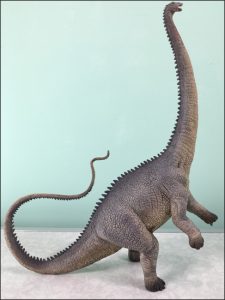Famous Swiss Palaeontologist is Honoured by Having Rare “Little Diplodocus” Named After Him
Dinosaur Discovery from Wyoming Honours Hans-Jakob Siber
A long-necked sauropod, believed to be closely related to the famous long-necked dinosaur Diplodocus has been named after a Swiss-based researcher who has made a substantial contribution to the study of dinosaur fossils. The new dinosaur species has been named Kaatedocus siberi to honour Hans-Jakob Siber, widely regarded as one of Switzerland’s most influential dinosaur experts. Dr Hans-Jakob Siber, is the founder and director of the Dinosaur Museum at Aathal, close to Zurich. The name means “Siber’s small diplodocid” and it has been described from a partial skeleton excavated from a sequence of Upper Jurassic strata which forms part of the famous Morrison Formation in the western United States.
An exhibit featuring this new sauropod species is due to open at the Aathal museum, a chance for the Swiss public to gain an appreciation of the research work carried out by Dr Hans-Jakob Siber and his colleagues.
New Dinosaur Species
For the last twenty years or so, the Swiss research team have visited a number of locations within the Morrison Formation of the United States to carry out excavations and other field work. The new discovery comes from the Big Horn Basin area of Wyoming. Over the years, the Swiss team have explored a number of fossil bearing sites, areas such as the Dana Quarry (Ten Sleep) and the Howe Ranch in central Wyoming. They have found a number of specimens, including Apatosaurus, Allosaurus and Stegosaurus, but this is the first dinosaur from the Wyoming site to be named in honour of one of the team.
New Member of the Diplodocid Clade – Kaatedocus siberi – Honours a Swiss Palaeontologist

A newly described diplodocid dinosaur honours a Swiss palaeontologist. A typical diplodocid dinosaur is illustrated.
Picture credit: Everything Dinosaur
Cervical (Neck Bones)
Importantly, the fossil material ascribed to this new dinosaur genus includes a number of beautifully preserved cervical vertebrae (neck-bones), these well-preserved bones will help palaeontologists to explore the subtle differences between this type of long-necked, plant-eating dinosaur and those that evolved slightly later in the Jurassic, dinosaurs such as the famous Diplodocus.
Like Diplodocus, Kaatedocus, had a small head on a long neck, a huge body, supported by pillar-like legs and a whip-like tail. Kaatedocus lived around 153-150 million years ago, making this fossil specimen an earlier example of a diplodocid dinosaur when compared to Diplodocus genera. The fossils were also found further north than the majority of other Upper Jurassic diplodocid remains associated with this part of the Morrison Formation. It could be speculated that the diplodocids, gradually moved south, adapting to new environments and climatic conditions as this particular type of dinosaur evolved.
Kaatedocus siberi
The specimen was first excavated by the Swiss team nearly twenty years ago, it was one of the first significant dinosaur bone assemblages they discovered, but the researchers opted to focus on working on more complete specimens so the importance of their fossil find was overlooked. They were not aware that they had actually discovered an entirely new species of Late Jurassic dinosaur.
For models and replicas of diplodocids and other Late Jurassic dinosaurs: Late Jurassic Dinosaur Models and Prehistoric Animal Figures (CollectA).
Fellow Swiss palaeontologist Emanuel Tschopp was responsible for the formal study of the specimen, including the analysis of a partial skull. His paper has been published in the academic journal “The Journal of Systematic Palaeontology”. In naming this new sauropod, it was an opportunity to honour the work and contribution of Dr Hans-Jakob Siber.
Kaatedocus was actually smaller than the likes of Diplodocus longus, however, the single individual known was a sub-adult. The fact that this dinosaur was not fully grown and has left some very well preserved cervical vertebrae has provided palaeontologists with an opportunity to study how these type of dinosaurs grew (ontogeny).
To read an article on previous studies related to diplodocid ontogeny: Baby Faced Dinosaurs.
Diplodocid dinosaurs include Late Jurassic giants such as Apatosaurus and Barosaurus. This clade survived into the Early Cretaceous, evolving into some bizarre forms such as the South American Amargasaurus and the dinosaur that thought it was a “lawn mower” the African diplodocid Nigersaurus (Nigersaurus taqueti).

